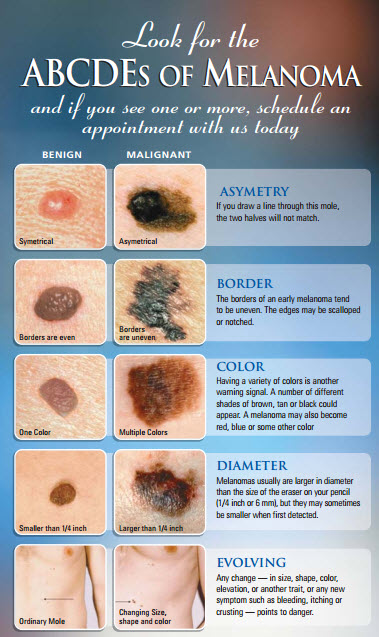


The best way to identify skin cancers in their earliest stages: Call the office to schedule an annual skin cancer checkup. Some moles may look unusual without being cancerous, and some melanoma lesions may not conform to the ABCDE system. It’s important to note that these changes can occur in any mole, including moles you may have had since childhood.Īlthough the ABCDE guidelines can be helpful, they aren’t 100% foolproof. If your mole has changed in color or size, if it’s suddenly become itchy, if it’s oozing, or if it’s changed in another way, that could be a sign of skin cancer. The general guideline: Cancer is typically associated more often with moles that are larger than a pencil eraser or pea. D is for diameterĬancer can cause changes that make the mole appear larger. If a mole has more than one color or if it’s mottled or blotchy-looking, it could be a sign of skin cancer.

Most normal (noncancerous) moles are uniform in color. The key thing to look for here is a change in color or a mottled appearance. Moles can vary in color from pinkish to blackish brown. Cancerous moles often have borders that are irregular or jagged-looking. B is for bordersīorders refers to the edges or margins of the mole. Do the two sides look about the same or are they different? Asymmetry could be an indication of cancer. Imagine a line extending down or across the middle of the mole. ABCDE stands for different types of changes or characteristics typically associated with melanoma. The ABCDE method was developed to make it easier for clinicians and patients to remember what to look for when evaluating moles. Part of that evaluation includes what’s called the ABCDE method - and the good news is, you can apply the ABCDE method to examine your moles at home, too. The most serious and deadly type of skin cancer, melanoma, is often associated with moles, and identifying moles that could be cancerous is an important part of making sure you get treatment as early as possible.Īt Starkey Medical Esthetics in Salem, Virginia, Michele Meinhart, FNP, and her team use state-of-the-art dermatology methods to evaluate moles and determine if cancer cells are present. Skin cancer is the most common cancer in the United States, affecting 20% of Americans by the time they reach their senior years.


 0 kommentar(er)
0 kommentar(er)
